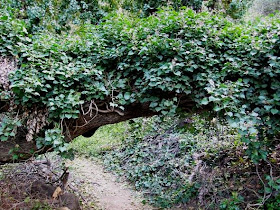
Hiked on March 24. Took a while to write up this hike. I think I still need to edit and add some pictures. However, it's been a while, so I figured I'd publish this hike write-up now, and go back and edit it when I have more time.
Getting back to March 24--This was my fourth hike up to the top of Mt Wilson this year. It's also the same hike I took for Hike #16, but in reverse. But I never wrote up that hike, did I?
Well, both hikes started from Chantry Flats. I got to the parking lot about 10:15am, which is actually about as early as I've ever managed to get started on a Mt. Wilson hike this year.
The Sturdevant Trail requires a rapid decline down the paved road. Along this section, there's a number of bushes covered with yellow flowers. The bush looks like a palo verde, but I don't think it is. It could be a mesquite, but I'm not sure:

After the end of your descent, you cross the bridge over Winter Creek, then bear right (instead of left, which goes up the Lower Winter Creek Trail). About a half mile later, you come to fork in the trail. To your left are two trails: the Upper Sturdevant Trail, and the Gabrielino Trail. Meanwhile, the trail to Sturdevant Falls continues straight ahead, ending at the base of Sturdevant Falls continues straight ahead, and ends at the base of the falls.
Since my destination was Mt. Wilson, I took the Upper Sturdevant Trail. The mileage sign indicates it's 5.5 miles from here to Mt Wilson (via the Upper Sturdevant Trail). Along the way, you parallel Sturdevant Creek for about a half-mile, until this trail and the Gabrielino Trail merge. You continue mostly paralleling this canyon as you make your way past Cascade picnic area, Spruce Grove Campground, and Sturdevant Camp.
Within 100 yards of beginning up the Sturdevant Trail, there's the remains of an old cabin to your left.

The Sturdevant Trail splits from the Gabrielino Trail just before you get to Sturtevant. However, currently, the Gabrielino Trail is closed, as part of the Station Fire recovery order, so your only choices at the moment are to turn around here, or continue to your left, along the Sturdevant trail.
An 1/8 of a mile after leaving the Gabrielino Trail, you come to a junction with the Zion Trail, which would take you back towards Chantry Flat, with a short spur available to Mt. Zion.
After the Zion trail junction, the Sturdevant Trail begins a pretty steep and continuous climb up towards the Mt. Wilson Observatory. It's a tiring climb, but still more shaded than the Mazanita Trail.
Just before you reach the mountain top, you'll see a short spur to your east. It's got wires strung along poles to provide a protected access to an overlook. From the lookout point, the dome housing the 100-inch telescope is directly to your north. You can also see along where the Rim Trail runs (although it is also currently closed as part of the Station Fire recovery order).


Returning to the trail, the 60-inch telescope dome is to your left. Several of the smaller domes that make up the CHARA array will also be visible on your walk.
If you continue towards the 100-inch telescope, there's a water fountain next to an astronomers' residence. The water tasted pretty darn good that day. :D I decided that getting your friends to build a water fountain in your memory would be a pretty good way memorial.

Heading further to the west along the paved road that runs along the top of Mt. Wilson, you'll pass the solar observatory. That's a picture of the solar observatory tower at the top of this post.
You'll also pass the astronomy museum. It was locked when I came by, probably because the road to Mt Wilson is still officially closed to the general public. I've been in it before, however--it's got a lot of pictures, many with revised captions that indicate some of the changes in our knowledge of the universe since those pictures were first displayed.

I also passed several burned logs and bushes. I don't know if they were burned as part of the wildfire, or burned as part of the backfire that was set to save Mt Wilson's scientific and historic resources.

A bit further west and the road provides access to the large parking lot that is at the top of the Mt Wilson Trail. The pavilion overlooks the parking lot.
I'm pretty sure I've blogged about the Mt Wilson and Upper Winter Creek Trails previously, but that was my return path.
I got to the top of Mt. Wilson around 2:15pm, and back to my car by 5:30pm. That's with lots of stops for pictures and snacks along the way.











































